BRIAN CHOO'S AQUARIUM PAGE
(please wait for the images to load)
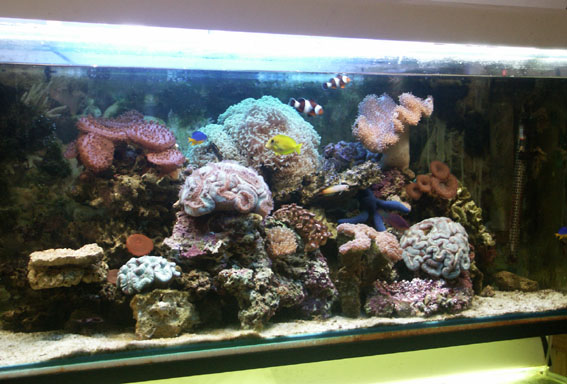
(02/01/2005)
Hi!
On this webpage, I share with you some images of the creatures that dwell in my marine aquarium. I first started setting up the reef tank in July 2003 (from 1996 onwards the tank held African rift-lake cichlids and before then it was a fish-only saltwater tank). The nitrogen-cycle was established in mid-August and the first livestock added shortly after. I live in Perth, Western Australia.
Here we have an overall view of my setup as it appears in January 2005. Beneath the reef tank is my gulf saratoga (Scleropages jardini) - a predatory freshwater fish. If only the inhabitants of the reef knew of the monster lurking just beneath them! The reef community has been in this stable state since about March 2004, the only recent additions being the surgeonfish, the bubble coral and one of the rose corals.
This is how the tank looked way back in late September 2003, 3 months after initial setup and shortly after the first batch of corals was added.
Unfortunately things went downhill the following February during a terrible heatwave. As of our electrical supplier was unable to cope with the anticipated power blowout, they posted bogus warnings threatening legal action if we did not turn off our air-conditioners. The water in the tank shot well over 33 degrees and many corals deteriorated. In the ensuing public outrage, those in charge of the power company we're sacked by the state government.
Fortunately all the fish survived as well as Link the starfish.
NOTABLE CREATURES IN RESIDENCE

The most recent fish addition is Lemony the surgeonfish (Nov 2004). He is a juvenile (5 cm) Acanthurus olivaceus or Orange-spot surgeonfish who flew in all the way from Vanuatu. An extremely active fish, he likes to graze on the filamentous algae that grows on the back of the tank. At about a foot long when fully grown, he will eventually have to be moved to his own tank. (left)
I was reluctant to get an acanthurid based on experiences in fish-only marine aquaria in the early 1990s. I found surgeons to be susceptible to disease and highly aggressive. My powder-blue tang - Acanthurus leucosternon - massacred all but a few selected tankmates back in 1994.
However, Lemony has proven to be a perfect tankmate, remaining spotless and well behaved.
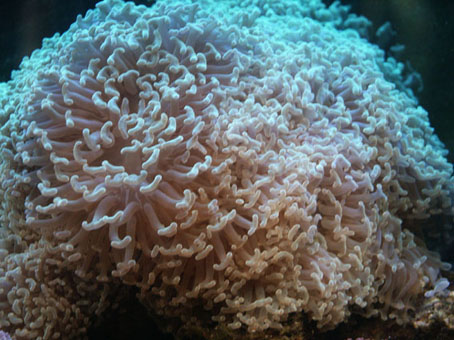
The centerpiece of the tank is this large colony of hammer coral ( Euphyllia ancora) that is about 40cm in diameter when fully spread out. Euphyllid corals are highly aggressive, sending out long sweeper tentacles to attack their neighbours so I have to take care to position other corals out of range. I added the colony in April 2004 and it has maintained its size since then. (right)
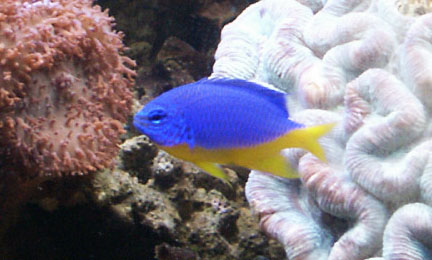
Conspicuous with their intense electric-blue colouration are my two azure damselfish (Chrysiptera hemicyanea) that have been in the tank almost from the beginning. There are several geographic varieties of this species with varying amounts of yellow - this Indonesian form has the greatest amount of yellow and is sold as the "Kupang damselfish". (left)
Damselfish are territorial although this form is nowhere near as psychotic as some of its relatives. These two have neatly divided the tank in half, each largely keeping to one side of the aquarium and chucking a hissy-fit when it sees the other venturing beyond the territorial boundary.
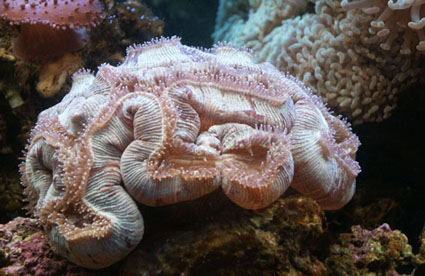
My vote for the most indestructible stony coral in captivity goes to the lovely rose coral (Trachyphyllia geoffroyi). Unless you commit really monumental blunders or acts of laziness, this is a species that always comes back for more - my oldest colony was the only stony coral to survive the heatwave and has grown considerably in since then. They're also dirt cheap at $9.50 Australian each at the local aquarium store.
I currently have four colonies in the tank - the only loss was when the starfish knocked one colony over, sending it tumbling into the tentacles of the hammer coral where it was promptly digested. (right)
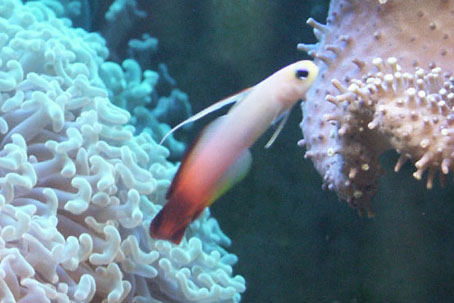
Delicate beauties are my two firegobies (Nemateleotris magnfica ). Extremely shy when first introduced in late 2003, they have settled in nicely and are a constant source of attention as they flick their long dorsal-spines up and down.
The larger animal eats like a pig and has become quite boisterous, picking fights with the damselfish. By Jan 2005 it had grown to over 6 cm long, which must be close to the maximum size for this species. The smaller of the original pair died suddenly in May 2004 and was soon replaced - it seems to be getting along fine with the older fish. (left)
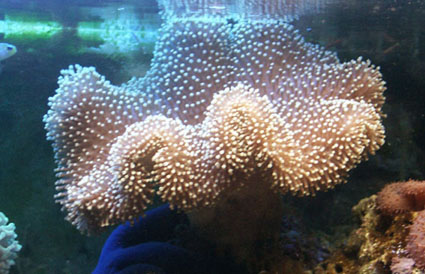
The leather coral (Sarcophyton trocheliophorum) is an unpredictable fellow (or rather fellows since it is actually colony of individual polyps). Over the course of the week it slowly changes its shape and orientation, varying from a pale blob to its fully extended glory where it is close to a foot across. The colony has been growing like crazy and several times I've had to place the colony deeper in the water to prevent it from touching the surface (as shown here). (right)
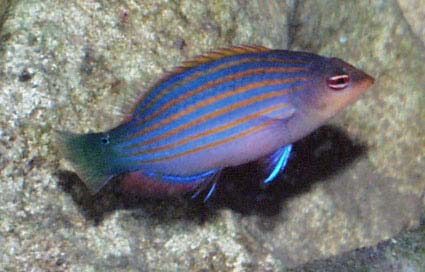
The first fish in the tank (Sep 2003) was PJ the six-lined wrasse ( Pseudocheilinus hexataenia). Despite his colourful attire, he can be hard to spot as he spends much time exploring the cave network for tidbits. At feeding time, PJ is the ultimate glutton, wolfing down great chunks of food and even stealing food from the tentacles of the corals. (left)
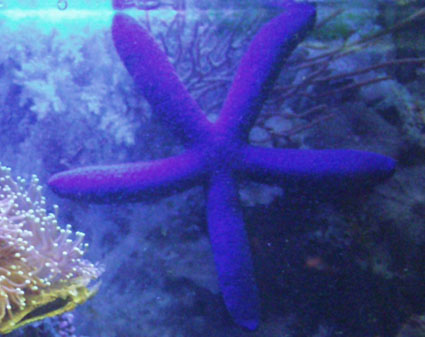
Introduced on the same day as PJ was Link the blue starfish (Linckia laevigata). If PJ is the ultimate glutton, then Link is the ultimate couch-potato, always slouched over a rock or in some corner of the tank. From the tips of his arms, he is a little over 20cm across. He normally scavenges for food but I still feed him once a month by placing him over a cube of marine mix - contrary to some sources a healthy linckia will avidly accept supplemental feedings although they like their food in small bits and reject large chunks.
I have found linckias to be as tough as nails, despite conflicting accounts from American sources. I've never seen a linck' in a Perth petstore in less than immaculate condition, never suffering the blemishes and parasitic molluscs I've seen in photos of American specimens. Apparently this species doesn't ship well overseas, but in Perth we're only hours from the source - many are locally caught in Karratha - and our stars arrive in top shape.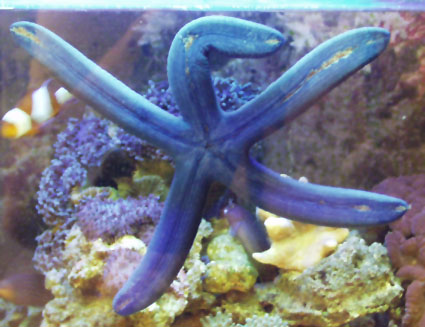
I guess its a regional perk of living in Western Australia - but not everything goes our way, for example WA specimens of the normally hardy torch coral (Euphyllia glabrescens) has a poor captive track record (specimens from Qld or Indonesia usually do fine).
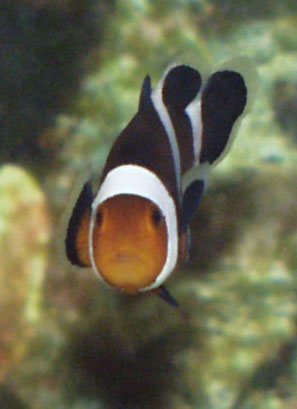
"It's Nemo!!!"
If I had a dollar for the number of times I've heard that one... The playful antics of my pair of common clownfish (Amphiprion ocellaris ) really liven up the tank. "Mr and Mrs Clowny" are captive-bred specimens (a increasing and pleasing trend among pet marine fish) and have thrived and grown since their arrival in September 2003.
It is obligatory to provide clowns with a host anemone but I knew that my lighting regime was nowhere near good enough for the Heteractis and carpet anemones that this species frequents in the wild. In the end I purchased a hardier bubble-tip anemone (Entacmaea quadricolor) which they promptly ignored in favour of a colony of torch coral (Euphyllia glabrescens ). When the coral died, they accepted the bubble-tip - until the dumb anemone crawled to the back of the tank and refused to budge. Now they spend their nights rubbing against the Rhodactis corallimorphs. (left)
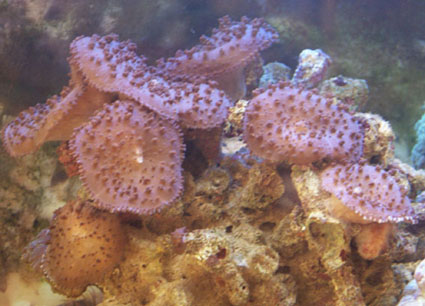
While rose corals may be the easiest stony corals to keep, the corallimorphs or mushroom polyps are the easiest cnidarians period! They only problem with them is their inoffensiveness which puts them on the losing end in encounters with more aggressive corals. There are at least three species in my tank, the most spectacular of which are these large Western Australia Rhodactis sp. which are up to 12 cm in diameter. (right)
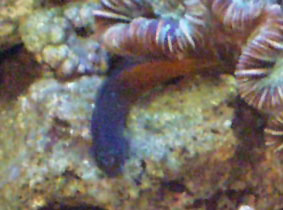
While one of the more cryptic tank denizens, the bicolor blenny ( Escenius bicolor) is certainly one of the more humorous as well. With it's odd, undulating swimming style, cute face and amusing "peekaboo" habits, it is difficult to watch this fish and keep a straight face. (left)
A crap photo I know...
My most recent invertebrate addition is this bubble coral (Plerogyra sinuosa) that was purchased in December 2004. It is the coral on the left, alongside my largest rose coral on the right. A cousin of the hammer coral, it has settled in nicely at the time of writing and makes for a striking sight with its grape-like vesicles. (above)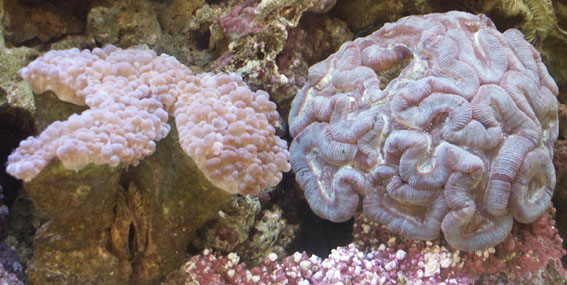
Probably my favourite fish is Mandy, a female ocellated mandarinfish (Synchiropus picturatus) that I've had since December 2003. Dragonets like Mandy do poorly in sterile fish-only aquariums as they require a population of tiny crustaceans to feed on that only a reef-tank provides. They also exude a noxious slime when stressed and dragonets are often called "stinkfish" by Australian trawl fishermen.
Mandy, although continually foraging amongst the live-rock, has learnt to accept frozen foods and will snap up brine shrimp, mysid shrimp, bloodworms and will even peck at frozen marine mix (though not with much gusto).
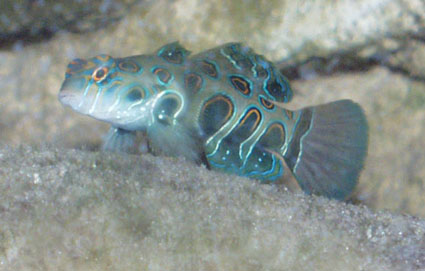

At left is Sluggo the aeolid nudibranch (Phyllodesmium sp.) . He has been in the tank from the beginning (Aug 2003), arriving on a piece of live rock. At 1.5cm long (the main body length), the mass of pale-tipped cerata growing from his body makes him look more like a mass of golf-putters than a slug. (left)
He is the nemesis of Aiptasia anemones (which multiply like rabbits), gorging down the babies like nachos but ignoring the large adults. He will disappear for months, only to appear whenever the Aiptasia start multiplying, keeping them in check.
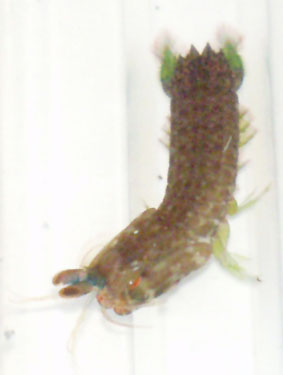
A creature that was briefly an inhabitant of the tank is Mantisa the mantis shrimp (Gonostomus sp.), a stomatopod who is currently about 8cm long. Like so many other small invertebrates, she arrived as a stowaway on some live rock. Despite her lovely colours, her predatory nature makes her a very poor tankmate and she had murdered several crabs before I got her out of the tank. However, she was such a cool animal that she ended up getting her own 5 gallon aquarium. Her attack-claws or dactyls pack an incredible wallop and have broken my fingernail on a number of occasions. (right)
Click here to see a Lovecraftian horror!
TANK STATISTICS
Tank dimensions
120 x 40 x 40 cm.
Filtration
Eheim professional 2229 wet/dry cannister filter
Air-powered protein skimmer.
Covering
30cm wide glass panels on edges of tank.
transparent plastic sheeting in the center of the tank (right below the actinic tubes which are suspended on a home-made wooden support frame)
Lighting
1 x Hagen Power Glo 40W 120cm fluorescent tube
2 x 20W 60cm blue actinic tubes
This is a little on the dim side for a tank of this size but I make sure that all photosynthetic critters are bunched beneath the actinics and positioned well off the floor of the tank. Tubes are replaced every 10-12 months.
Water characteristics
Temperature = 27 C
Nitrite = 0.001 ppm
Nitrate = never bothered to test it.
pH = 8.2
Specific gravity = 1.025
Water Changes
Change a 1x10L bucket of water every 3-4 days to which I add -
Aquasonic "Ocean Nature" synthetic sea salt
1 small glob of Aquarium Pharmaceuticals "Stress Coat".
2 capfuls each of the following -
Seachem "Reef complete"
Seachem "Reef carbonate"
Seachem "Reef plus"
Feeding
Generally twice a day I feed any one of the following -
a pinch of Aquasonic "Premium Marine Fish Food" (dried micropellets)
a cube of Hikari frozen brine shrimp
a cube of Hikari frozen mysid shrimp
a cube of Posaqua frozen marine mix
Whenever I use a frozen mix, I make sure that some "crumbs" fall onto the various coelenterates.
Once a week I add 3 ml of Aquasonic "Reef Nature" invertebrate food supplement.
About once a month, I manually place Linky the starfish over a 1/3 piece of Posaqua frozen marine mix which he avidly consumes over the next 24 hours.
Every few days I put in a pinch of torn up nori sheet for the Lemony the surgeonfish to munch on.
TANK CENSUS AS OF JANUARY 2005CHORDATA
1 x juvenile orange-spot surgeonfish (Acanthurus olivaceus)
2 x common clownfish (Amphiprion ocellaris)
2 x "Kupang" damselfish (Chrysiptera hemicyanea)
2 x magnificent firegoby (Nemateleotris magnifica)
1 x ocellated mandarinfish (Synchiropus picturatus)
1 x six-lined wrasse (Pseudocheilinus hexataenia)
1 x bicolor blenny (Escenius bicolor)
1 x unidentified seasquirt (started as a small blob on a piece of live rock in late 2003 - in Jan 2005 about 3 cm across)
ECHINODERMATA
1 x Blue starfish (Linckia laevigata)
tiny brittlestars
CRUSTACEA
Many small hairy crabs.
ANNELIDA
sabellid featherduster tube-worms (on live rock)
terebellid spaghetti tube-worms (on live rock and in coral skeletons - some have tentacles over 20cm long)
MOLLUSCA
1 x small abalone (Haliotus cf. varia)
2 x Trochus snails (herbivorous gastropods)
Many small Cronia snails (carnivorous gastropods up to 2 cm long).
1 x hammer clam (Malleus sp.) - bought as a "corallimorph rock" that turned out to be a large bivalve covered in Discosoma.
1 x frilly clam (Chama sp.) - again, a "corallimorph rock" that turned out to be a live bivalve!
1 x aeolid nudibranch (Phyllodesmium sp.)
Small mussels on live rock.
CNIDARIA
1 x Hammer coral colony (Euphyllia ancora)
1 x Bubble coral colony (Plerogyra sinuosa)
3 x Rose coral colonies (Trachyphyllia geoffroyi)
1 x Leather coral colony (Sarcophyton trocheliophorum)
1 x Brown zoanthid colony (Palythoa sp.)
Small smooth corallimorphs (Discosoma nummiformis)
Medium-sized fluffy corallimorphs (Discosoma sp.)
Large corallimorphs (Rhodactis sp.)
1 x Bubble-tipped anemone (Entacmaea quadricolor)
glass anemones (Aiptasia sp.) - ick, but whose offspring provide the only source of food for sluggo.
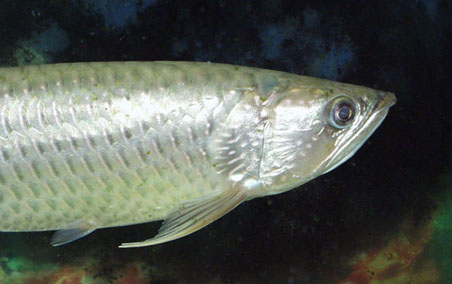
A closeup of saratoga